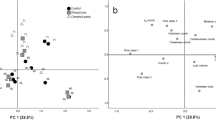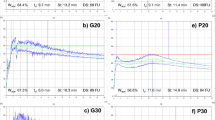Abstract
Cocoa bean shells (CBS) are by-products of cocoa processing. Their rich chemical composition makes them interesting ingredients to improve the overall quality of gluten free bread. The addition of different dimensional fractions (F1, 1.00–1.99 mm; F2, 0.50–0.99 mm; F3, 0.355–0.49 mm) of CBS to gluten-free bread was investigated in terms of volume, moisture content, crumb grain, texture and colour during 3 days of storage. No significant differences in moisture content were observed among fractions, but protein, fat and fibre content resulted influenced by the dimensional range. With reference to water absorption indexes, F2 showed the highest water binding capacity (WBC) and water holding capacity (WHC), having instead the lowest water solubility index (WSI), in comparison with the other fractions, and confirming a good retention of the fibres’ structure. Results on bread showed that CBS addition modified crumb grain leading to a lower specific volume, especially for F2. The presence of CBS accelerated significantly the crumb staling process in comparison with the control, resulting; however, F1 softer than control at the end of the storage period. Finally, colour was improved by the presence of CBS becoming darker, with F3 showing the highest impact on L* and a*.



Similar content being viewed by others
References
Faostat: Food and Agriculture Organization of the United Nations (2018). http://www.fao.org/faostat/en/#data/QC. Accessed 12 May 2020
Martínez R, Torres P, Meneses MA, Figueroa JG, Pérez-Álvarez JA, Viuda-Martos M (2012) Chemical, technological and in vitro antioxidant properties of cocoa (Theobroma cacao L.) co-products. Food Res Int 49:39–45
Okiyama DC, Navarro SL, Rodrigues CE (2017) Cocoa shell and its compounds: applications in the food industry. Trends Food Sci Technol 63:103–112
Okiyama DC, Soares ID, Cuevas MS, Crevelin EJ, Moraes LA, Melo MP, Rodrigues CE (2018) Pressurized liquid extraction of flavanols and alkaloids from cocoa bean shell using ethanol as solvent. Food Res Int 114:20–29
Panak Balentić J, Ačkar Đ, Jokić S, Jozinović A, Babić J, Miličević B, Šubarí D, Pavlović N (2018) Cocoa shell: a by-product with great potential for wide application. Molecules 23:1404
Arlorio M, Coisson JD, Restani P, Martelli A (2001) Characterization of pectins and some secondary compounds from theobroma cacao hulls. J Food Sci 66:653–656
Barbosa-Pereira L, Guglielmetti A, Zeppa G (2018) Pulsed electric field assisted extraction of bioactive compounds from cocoa bean shell and coffee silverskin. Food Bioprocess Technol 11:818–835
Hernández-Hernández C, Viera-Alcaide I, Sillero AMM, Fernández-Bolaños J, Rodríguez-Gutiérrez G (2018) Bioactive compounds in Mexican genotypes of cocoa cotyledon and husk. Food Chem 240:831–839
Mazzutti S, Goncalves Rodrigues LG, Mezzomo N, Venturi V, Ferreira SRS (2018) Integrated green-based processes using supercritical CO2 and pressurized ethanol applied to recover antioxidant compounds from cocoa (Theobroma cacao) bean hulls. J Supercrit Fluids 135:52–59
Martínez-Cervera S, Salvador A, Muguerza B, Moulay L, Fiszman SM (2011) Cocoa fibre and its application as a fat replacer in chocolate muffins. LWT-Food Sci Technol 44:729–736
Collar C, Rosell CM, Muguerza B, Moulay L (2009) Breadmaking performance and keeping behavior of cocoa-soluble fiber-enriched wheat breads. Food Sci Technol Int 15:79–87
Grillo G, Boffa L, Binello A, Mantegna S, Cravotto G, Chemat F, Dizhbite T, Lauberte L, Telysheva G (2019) Cocoa bean shell waste valorisation; extraction from lab to pilot-scale cavitational reactors. Food Res Int 115:200–208
Jozinović A, Panak Balentić J, Ačkar Đ, Babić J, Pajin B, Miličević B, Guberac S, Šubarić D (2019) Cocoa husk application in the enrichment of extruded snack products. J. Food Process Preserv 43(2):e13866
Rojo-Poveda O, Barbosa-Pereira L, Mateus-Reguengo L, Bertolino M, Stévigny C (2019) Effects of particle size and extraction methods on cocoa bean shell functional beverage. Nutrients 11:867
Kreibich HH, Moecke EOH, Scussel VM (2017) In: Méndez-Vilas A (ed) Microscopy and imaging science: practical approaches to applied research and education. Formatex Research Center, Badajoz
de Sousa MF, Guimarães RM, de Oliveira Araújo M, Barcelos KR, Carneiro NS, Lima DS, Egea MB (2019) Characterization of corn (Zea mays L.) bran as a new food ingredient for snack bars. LWT-Food Sci Technol 101:812–818
EC Regulation No 1924/2006 of the European Parliament and of the Council of 20 December 2006 on nutrition and health claims made on foods (2006) Off J Eur Union L404: 9–25
Association of Official Analytical Chemists (AOAC) (2002) Official method of analysis, 16th edn. Association of Official Analytical, Washington, DC
Sarangapani C, Thirumdas R, Devi Y, Trimukhe A, Deshmukh RR, Annapure US (2016) Effect of low-pressure plasma on physico–chemical and functional properties of parboiled rice flour. LWT-Food Sci Technol 69:482–489
American Association of Cereal Chemists (AACC) (2000) Approved methods of the AACC, 10th edn. American Association of Cereal Chemists, St. Paul
Rinaldi M, Paciulli M, Caligiani A, Scazzina F, Chiavaro E (2017) Sourdough fermentation and chestnut flour in gluten-free bread: a shelf-life evaluation. Food Chem 224:144–152
Bourne MC (1978) Texture profile analysis. Food Technol 32:62–66
Wu YV, Doehlert DC (2002) Enrichment of β-glucan in oat bran by fine grinding and air classification. LWT-Food Sci Technol 35:30–33
Knuckles BE, Chiu MM, Betschart AA (1992) Beta-glucan-enriched fractions from laboratory-scale dry milling and sieving of barley and oats. Cereal Chem 69:198–202
Raghavendra SN, Rastogi NK, Raghavarao KSMS, Tharanathan RN (2004) Dietary fiber from coconut residue: effects of different treatments and particle size on the hydration properties. Eur Food Res Technol 218:563–567
Lecumberri E, Mateos R, Izquierdo-Pulido M, Rupérez P, Goya L, Bravo L (2007) Dietary fibre composition, antioxidant capacity and physico-chemical properties of a fibre-rich product from cocoa (Theobroma cacao L.). Food Chem 104:948–954
De Angelis D, Madodé YE, Briffaz A, Hounhouigan DJ, Pasqualone A, Summo C (2020) Comparing the quality of two traditional fried street foods from the raw material to the end product: the Beninese cowpea-based ata and the Italian wheat-based popizza. Leg Sci. https://doi.org/10.1002/leg3.35
Pérez Sira E, Méndez A, León M, Hernández G, Sívoli L (2015) In: Pérez Sira E (ed) Cocoa byproducts technology, rheology, styling, and nutrition. Nova Science Publishers, New York
Martínez MM, Díaz Á, Gómez M (2014) Effect of different microstructural features of soluble and insoluble fibres on gluten-free dough rheology and bread-making. J Food Eng 142:49–56
Coda R, Kärki I, Nordlund E, Heiniö RL, Poutanen K, Katina K (2014) Influence of particle size on bioprocess induced changes on technological functionality of wheat bran. Food Microbiol 37:69–77
Gómez M, Moraleja A, Oliete B, Ruiz E, Caballero PA (2010) Effect of fibre size on the quality of fibre-enriched layer cakes. LWT-Food Sci Technol 43:33–38
Cappa C, Lucisano M, Mariotti M (2013) Influence of Psyllium, sugar beet fibre and water on gluten-free dough properties and bread quality. Carbohydr Polym 98:657–1666
Almeida EL, Chang YK, Steel CJ (2013) Dietary fibre sources in bread: influence on technological quality. LWT-Food Sci Technol 50:545–553
Kārkliņa D, Gedrovica I, Reca M, Kronberga M (2012) Production of biscuits with higher nutritional value. In: Proceedings of the Latvian Academy of Sciences. Section B. Natural, Exact, and Applied Sciences, vol 66, pp 113–116
Masure HG, Fierens E, Delcour JA (2016) Current and forward looking experimental approaches in gluten-free bread making research. J Cereal Sci 67:92–111
Guimarães RM, Pimentel TC, de Rezende TAM, de Santana Silva J, Falcão HG, Ida EI, Egea MB (2019) Gluten-free bread: effect of soy and corn co-products on the quality parameters. Eur Food Res Techn 245:1365–1376
Sharma P, Gujral HS (2014) Anti-staling effects of β-glucan and barley flour in wheat flour chapatti. Food Chem 145:102–108
Cai L, Choi I, Hyun JN, Jeong YK, Baik BK (2014) Influence of bran particle size on bread-baking quality of whole grain wheat flour and starch retrogradation. Cereal Chem 91:65–71
Rocha Parra AF, Ribotta PD, Ferrero C (2015) Apple pomace in gluten-free formulations: effect on rheology and product quality. Int J Food Sci Technol 50:682–690
Author information
Authors and Affiliations
Corresponding authors
Ethics declarations
Conflict of interest
The authors declare that they have no conflict of interest.
Compliance with ethics requirements
This article does not contain any studies with human or animal subjects.
Additional information
Publisher's Note
Springer Nature remains neutral with regard to jurisdictional claims in published maps and institutional affiliations.
Rights and permissions
About this article
Cite this article
Rinaldi, M., Littardi, P., Paciulli, M. et al. Effect of cocoa bean shells granulometries on qualitative properties of gluten-free bread during storage. Eur Food Res Technol 246, 1583–1590 (2020). https://doi.org/10.1007/s00217-020-03513-z
Received:
Revised:
Accepted:
Published:
Issue Date:
DOI: https://doi.org/10.1007/s00217-020-03513-z




